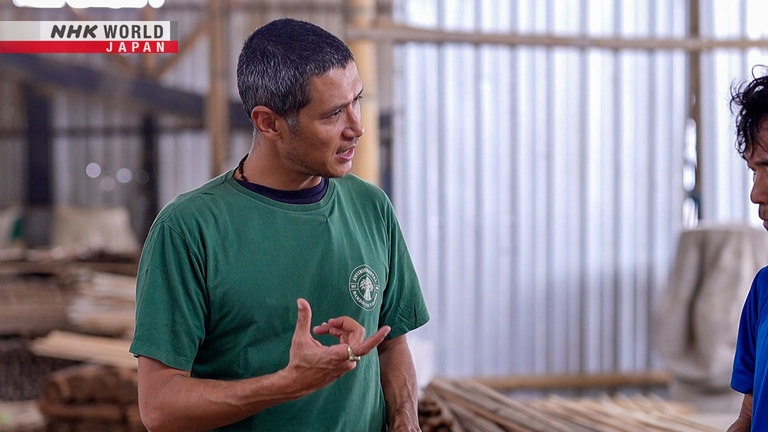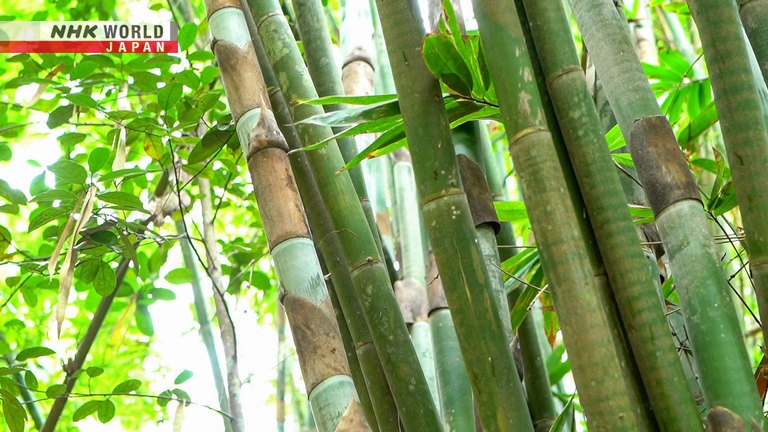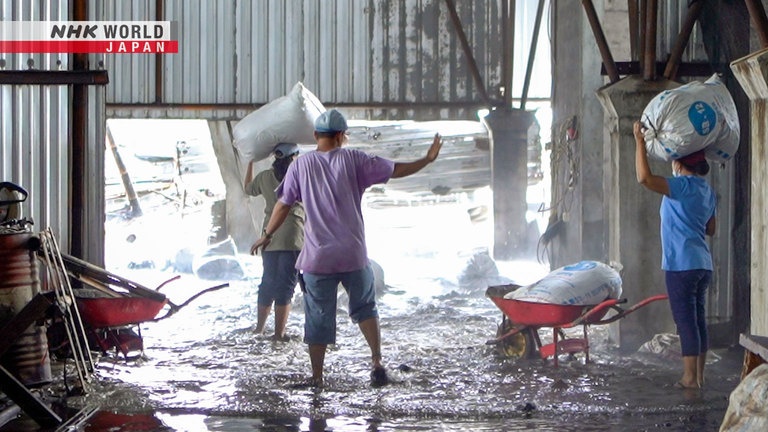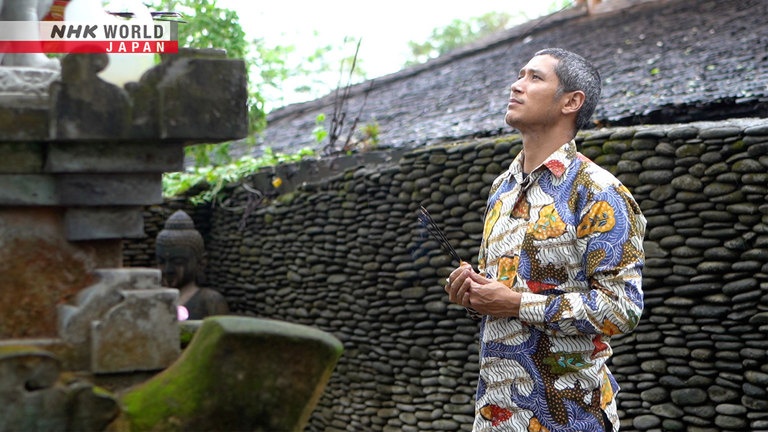Creating a Future With Bamboo: Arief Rabik / Senior Advisor, Environmental Bamboo Foundation
Indonesian social entrepreneur Arief Rabik has launched an eco-business aimed at revitalizing forests and rural economies by planting bamboo with local residents.




Transcript
Direct Talk
In Indonesia, where deforestation continues,
a social entrepreneur is on a mission
to revitalize the damaged environment
and bolster rural economies.
I love bamboo!
Arief Rabik has established an eco-business
in which he collaborates with villagers
to plant bamboo in depleted rural areas.
The bamboo is transformed
into wood alternatives.
The profits generated from these products
are returned to the villages.
This is finally something
that is a scalable solution.
Rabik's efforts are being recognized,
and in 2021,
he was appointed to the advisory board
for the UN Decade on Ecosystem Restoration.
Now, the threat of climate change
is affecting his business.
Bamboo is a tool
to create our shared global future.
Rabik believes that
bamboo plays a crucial role
in shaping a sustainable future
for the planet.
The islands of Indonesia
are home to the biggest
tropical rainforest in Southeast Asia.
But it is dwindling, due to large-scale
plantation development and timber production.
Many farming villages
are struggling as a result.
I had the pleasure of hiking
and walking in so many beautiful
natural environments
of Bali and of Indonesia.
And so it's been very sad to see, you know,
farmers and different companies
have to clear these lands for
agricultural activity, for plantations,
even for roads and for building.
And so it's been very hard
to see that because,
you know, my family were
very much environmentally focused.
So it hurt me a lot to see this.
Arief Rabik serves as the senior advisor of
the Environmental Bamboo Foundation in Bali.
This is a factory that he operates.
It processes finely cut bamboo
to make various products.
This is what we can
put together,
and make sustainable wood.
The sustainable timber of the future.
The bamboo is bonded with adhesive,
then pressed and transformed into sheets.
His business, centered on this factory,
has created almost 400 jobs.
These beams are stronger
and more durable than plywood.
This is a model home
made entirely out of bamboo.
This is an earthquake-proof design.
It was created with the assumption that
it would become public housing in the future.
This tableware is also made from bamboo.
It is sold in furniture stores and
other outlets overseas,
contributing to sales.
This is the replacement for concrete.
This is the replacement for steel.
This is the replacement for plastic.
This is the replacement for hardwoods.
It can really help to reduce the
environmental impact, reduce the emissions
of different products
that we now make out of
concrete, steel, plastic, wood, etc.
This is finally something
that is a scalable solution.
Takenoko (Bamboo shoot).
Very yummy.
Rabik grew up in Bali,
surrounded by nature from a young age.
It was his mother,
renowned Irish interior designer
Linda Garland,
who sparked his interest in bamboo.
This bamboo sofa is
one of her signature pieces.
Her rustic furniture, made from
Indonesian bamboo, was adored by many people,
including celebrities such as
David Bowie and Mick Jagger.
my mother
was
a beam of light and happiness.
My mother would always invite
my brother and I to join
different gatherings of bamboo and just
have different people
speak to us and inspire us.
And so
her influence was soft,
but very powerful.
Rabik's mother had a deep love
for Indonesian bamboo.
She founded the
Environmental Bamboo Foundation
and began an initiative of
planting bamboo on degraded land,
breathing new life into rural villages.
Inspired by his mother,
he entered a university in Australia
to lay the groundwork for his future.
I saw already, you know,
in my high school period,
a lot of issues of degradation.
And I really wanted to help,
especially from the management side.
So actually, I did a double degree
in environmental management
and in organic environmental chemistry.
then I started to create my own path
for my thinking on
how we can make this
bamboo revolution come true.
After completing his specialized studies,
he returned to Bali and
began to assist with his mother's foundation.
His team built a bamboo-processing factory,
taking his community
revitalization to the next level.
However, he encountered numerous challenges.
Nature was also unforgiving at times.
One day, the factory was inundated
by massive waves and left flooded.
A storm had hit Bali, causing rough seas.
Although there was a seawall
next to the building,
the waves had managed to breach it.
The staff quickly prepared sandbags
and worked together as a team
to keep the water out.
The battle with the waves
continued for two hours.
Is this happening before?
This was not happening before.
This is climate change.
Sea level rise.
When we bought this land
the ocean was 200m out there.
Now sea level
has come 200m in.
So after many people complain,
they built
they built this wall to protect us.
But it needs more.
Sea will continue to rise.
So climate change
really affects your business too.
This is it.
Absolutely crazy.
Rising sea levels is not the only concern.
Frequent wildfires and floods are
causing further suffering in rural areas.
Rabik believes that bamboo is the key to
rejuvenating devastated forests and farmland.
This is because bamboo
has many remarkable properties.
One of them is its ability to retain water.
When bamboo is grown alongside other plants,
their roots intertwine and create
a strong water-holding system in the soil.
So they say that bamboo is like a rain suck.
So if you mix it in the right
agroforestry system with,
for example, Nangka (jack fruits) ,
which is a deep root species,
the coconut tree over there,
which is a medium root species,
and then bamboo,
which is a shallow root species,
So all those soil in this area
is all knitted up with roots.
And every time it rains,
it sucks up the water
and becomes a reservoir of water,
a sink of water, a pool of water
that then keeps all the plants
irrigated all year round.
So this is why biodiversity is so important.
And so with this agroforestry system,
the bamboo grows very quick.
We can restore degraded lands,
we can absorb 50 tons of carbon dioxide
per hectare per year.
Studies show that bamboo absorbs
35 percent more carbon dioxide
and produces more oxygen than trees.
Rabik is currently leading
the "Bamboo Village" project
in 127 locations across Indonesia,
aiming to revive forests by
planting bamboo on degraded land.
Once the bamboo matures, factories will be
built in local villages to process it.
So this is what we want
the communities to sell.
The rough sticks,
and then the pellets or
briquette from the waste.
This solid fuel is made from scraps
that are produced when shaping bamboo pieces.
Bamboo is utilized without waste,
generating cash income for the villages.
And because of its rapid growth,
it can be expected to provide
a steady stream of revenue.
So a bamboo village is really a partnership
between 200 households.
These communities get a huge livelihood
because they can get an
annual harvest every single year
from this agroforestry area.
So it's definitely a profitable system
and that's the only way we think
that these restoration activities
can work going forward.
They must be a successful business.
One of the challenges was gaining
the understanding of local people.
They had been exploited in the past and
were reluctant to accept any new proposals.
I think probably the hardest thing is to
convince many, many of
these farming communities
that this restoration economy model
that we are creating is real.
And it's not just another program
that will somehow exploit them.
So how to slowly build the relationships
is a big, big challenge and it still is now.
You know, in every new area,
we cannot talk about
building a relationship in months.
Impossible.
We talk about years
and we say that we are committed
to work with them
forever more as their partner.
You know, we are not a project.
We are a partner.
"Villagers have the power to change
not only their own communities
but also society at large."
Rabik's mother passed on this wisdom
to him before her death in 2017.
Her love for bamboo and
the people of rural communities
lives on in Rabik
as he continues his endeavors.
my mother was very community per community
and her approach was
very much just looking at how to customize
what that community needed to be successful,
which is a beautiful approach.
If there was one thing
I would want to say to the world, it's
trust
rural people
to be
the restoration champions
of our shared future.
We must value these rural people
and give them support and give them resources
and we must have communities
have the power
to grow the bamboo
to restore the degraded lands.
This is the only way that bamboo would work
for the long time.
Rabik's goal is to establish 1,000
bamboo villages in Indonesia and elsewhere.
We asked Rabik to write some word summing up
his philosophy on a piece of bamboo.
Let's learn to love and value bamboo
to help our future be green and beautiful.
humanity must believe that
humanity is part of nature,
and humanity must believe that
we need to think long term.
We need to think 1000 years into the future
and have the reality of 1000 years
from now affect our choices today.
short term profit, short term happiness,
short-term, short-term, short-term thinking.
It's boom and then bust.
And so we must just
move away from this thinking.
And so I believe that forests
and people need to come together
for the future of our humanity.
Bamboo.